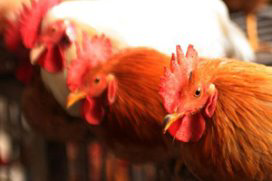UK campylobacter data ‘out of date’, processors suggest

UK poultry processors say they are achieving considerable success in driving campylobacter levels lower, and have suggested data released by the country’s Food Standards Agency (FSA) is out of date.
The FSA published its full report into its first year of sampling retail chicken for campylobacter on Thursday (10 September).
The headline figures are no different to those released at the end of May, which showed that 73% of supermarket chicken tested positive, and 19% was in the highest bracket, with more than 1,000 colony forming units per gramme (cfu/g). Of the seven UK retailers monitored, Tesco had the lowest contamination rate, and Asda the highest.
But the report does contain additional detail, including information on which processors supplied the highest and lowest levels of campylobacter, and how birds compared according to their size and the system they were reared under.
On this latter point, there is some suggestion that organic birds had higher levels of campylobacter than standard or free-range birds, with 29% in the highest contamination bracket. But the report notes that “as only 28 were tested in this survey (of more than 4,000 samples) there is limited statistical power to make any conclusive statements”.
Also read this blog: One health – are we getting any closer?
Bird size matters
The information on bird size was more convincing, with 23% of large birds having more than 1,000cfu/g, compared with 14% for small birds.
“It is possible that the heavier birds reflect thinned batches, which are known to be more likely to be contaminated,” said the report.
As for the individual processors, the FSA for the first time has revealed the approval numbers of these plants against the sample results.
From this it emerges that, out of the 12 operators listed, the lowest levels of campylobacter were found on samples from Moy Park’s Sleaford and Dungannon factories, while the highest levels came from Faccenda, Brackley, and Banham Poultry, Attleborough.
But a spokesman for Faccenda explained that things have moved on significantly since the samples were taken. The company has installed SonoSteam technology to its processing lines to kill the bacteria on the chicken, with good effect.
“The FSA’s report is a useful reminder of how important the issue is, but data that’s between six and 18 months old isn’t an accurate reflection of where we are now,” he said.
“Compared with the statistics quoted in the report, our latest testing indicates we have more than halved the percentage of our whole birds with the highest concentrations of campylobacter,” said the spokesman.
Also read: Likely cause of spotty liver in layers identified
Reduction programme
Leading processor 2 Sisters Food Group also said it is making good progress to get campylobacter levels down, having invested £10m in a reduction programme.
Measures taken include boosting on-farm biosecurity, running a no-thinning trial, blast surface chilling of carcasses and secondary scalding.
“Our reduction plan continues at pace, though it won’t be until later this year that the full impact of our actions will start showing in the FSA data,” said a statement.
The FSA said it has now embarked on a second year of testing, including discounters Aldi and Lidl for the first time, and the first results will be published in late November.
What’s on the wrapper?
The FSA’s full report also reveals the extent of campylobacter found on the outer packaging of shop-bought chicken. While low at 6.8%, the FSA said it is still concerning.
“Consumers would not expect products to be contaminated on the outside, and no specific instructions are provided with regard to the safe handling of such packaging before opening.”
Asda and Morrison’s had the highest levels of packaging contamination, while Tesco and M&S had the lowest.
Source: Poultry World













